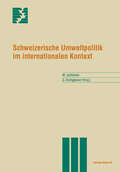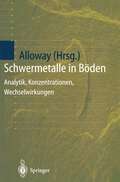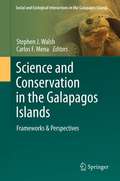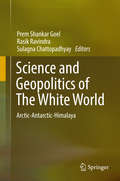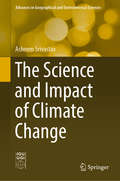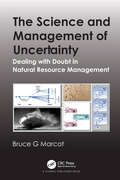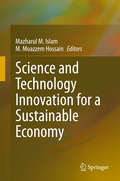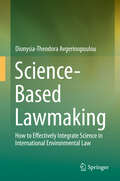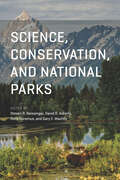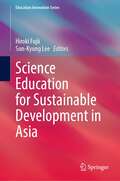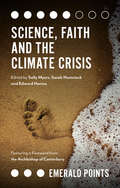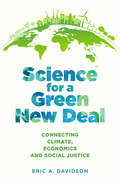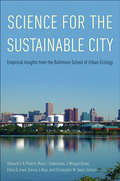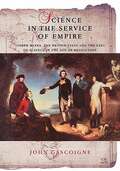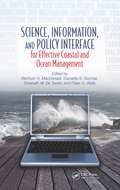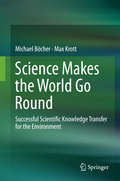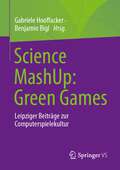- Table View
- List View
Schweizerische Umweltpolitik im internationalen Kontext (Themenhefte Schwerpunktprogramm Umwelt)
by Maren Jochimsen Gebhard KirchgässnerGerade für ein hochentwickeltes Land wie die Schweiz mit - im internationalen Ver gleich - recht hohem Umweltstandard ergeben sich heute die grössten Umweltgefahren aus internationalen bzw. globalen Umweltproblemen: der Abbau der Ozonschicht sowie die möglichen Konsequenzen einer Erwärmung der Erdatmosphäre seien als wichtigste Beispiele genannt. Dagegen scheint sich die Erkenntnis, dass nicht nur der Zustand der natürlichen Umwelt, sondern auch die Möglichkeiten und Chancen der schweizerischen Umweltpolitik nicht unabhängig davon sind, was im Ausland geschieht, im politischen Raum nur sehr allmählich durchzusetzen. Umweltpolitik wird noch viel zu häufig als reine Innenpolitik betrachtet; eine 'Umweltaussenpolitik' findet kaum statt. Aber auch in der (sozial-)wissenschaftlichen Forschung werden Umweltprobleme häufig als rein nationale Angelegenheiten angesehen: In neueren Übersichten zur ökonomischen Theorie der Umwelt finden sich beispielsweise kaum Hinweise auf die internationale Dimension dieser Probleme und die sich daraus ergebenden Bedingungen für Lösungsansätze. Vor diesem Hintergrund war es sinnvoll, dass im Rahmen des Schwerpunktprogramms Umwelt des Schweizerischen Nationalfonds die drei Projekte, die sich mit internationalen Aspekten schweizerischer Umweltpolitik beschäftigten, im koordinierten Projekt "Interna tionaler Kontext der schweizerischen Umweltpolitik" zusammengefasst wurden, als dessen Sprecher Prof. Dr. GEBHARD KIRCHGÄSSNER (Hochschule St. Gallen) fungierte. Es handelt sich dabei um die Einzelprojekte "Umweltrelevante Auswirkungen des europäischen Integra tionsprozesses in der Schweiz - Vorschläge für flankierende Massnahmen zur Eindämmung ökologisch unerwünschter Effekte" unter der Leitung von Dr. CHRISTIAN HANSER (Brugger, Hanser und Partner, Zürich), "Die Möglichkeiten und Grenzen einer internationalen Um weltpolitik der Schweiz" von PD Dr.
Schwermetalle in Böden: Analytik, Konzentration, Wechselwirkungen
by Brian J. Alloway T. Reimer R. EisSchwermetalle sind von Natur aus in allen Böden vorhanden. Die jeweiligen Gehalte sind dabei abhängig von den in den bodenbildenden Ausgangsgesteinen vorhandenen Konzentrationen, von den chemischen Eigenschaften der einzelnen Schwermetalle und von der Entwicklungsgeschichte der Böden. Von einer wirklichen Belastung für den Boden kann daher nur bei zusätzlich anthropogen verursachtem Schwermetalleintrag gesprochen werden. Der erste Teil des Buches führt in die natürlichen Bodenprozesse sowie in die Chemie der Metalle und deren Analytik ein. Der Hauptteil beinhaltet detaillierte Informationen zu den einzelnen Schwermetallen, deren spezifischen Wechselwirkungen mit Böden und Pflanzen und zeigt Möglichkeiten der Melioration bzw. Sanierung auf.
Science and Conservation in the Galapagos Islands: Frameworks & Perspectives (Social and Ecological Interactions in the Galapagos Islands #1)
by Stephen J. Walsh and Carlos F. MenaIn this launch of the Galapagos series, this book provides a broad “framing” assessment of the current status of social and ecological systems in the Galapagos Islands, and the feedback that explicitly links people to the environment. It also highlights the challenges to conservation imposed by tourism in the Galapagos Islands and the attendant migration of people from mainland Ecuador to service the burgeoning tourism industry. Further, there is an emphasize on the status of the terrestrial and marine environments that form the very foundation of the deep attraction to the Islands by tourists, residents, scholars, and conservationists.
Science and Geopolitics of The White World: Arctic-Antarctic-Himalaya (Society Of Earth Scientists Ser.)
by Prem Shankar Goel Rasik Ravindra Sulagna ChattopadhyayThis book brings together thirteen selected papers presented in the Third International Seminar on Science and Geopolitics of Arctic-Antarctic-Himalaya, held in India in September 2015. The papers and have been grouped according to the Seminar’s three main themes: a) Geopolitics of the Polar Regions, b) Global Climate Change and Polar Regions, and c) Climate Change and Himalayan Region.
The Science and Impact of Climate Change (Advances in Geographical and Environmental Sciences)
by Asheem SrivastavThis volume provides a holistic and concise overview of the complex science of climate change involving the interplay of multiple factors. It also acts as a primer and a one-source reference to all the aspects of climate change, allowing researchers to understand the complexity of this science and to see the larger picture, thereby aiming towards holistic solutions.Beginning in the second half of the twentieth century, the impacts of climate change have been the worst nightmare to hit humanity so fiercely, causing loss of human life and irreparable destruction to natural and man-made infrastructure in many parts of the world. The difference between climate change now and in the past is that of sudden and disproportionate disruption of the natural energy dynamics by the changing consumption patterns of billions of human beings who, in their quest for economic superiority, have polluted the terrestrial and aquatic ecosystems. The picture that emerges from the exhaustive analysis of international data drawn from the most reliable sources indicates that we have possibly gained access to the gateway of extinction and it is time that we take corrective steps immediately.The book’s chapters not only provide an overview of climate change science but also include detailed discussion on current research. This unique analytical text is suitable for conservation environmentalists, researchers, and academicians working in the field, along with policy makers, research and training institutes, and nongovernment organizations.
The Science and Management of Uncertainty: Dealing with Doubt in Natural Resource Management
by Bruce G. MarcotUncertainty can take many forms, can be represented in many ways, and can have important implications in decision-making and policy development. This book provides a rigorous scientific framework for dealing with uncertainty in real-world situations, and provides a comprehensive study of concepts, measurements, and applications of uncertainty in ecological modeling and natural resource management. The focus of this book is on the kinds and implications of uncertainty in environmental modeling and management, with practical guidelines and examples for successful modeling and risk analysis in the face of uncertain conditions and incomplete information. Provided is a clear classification of uncertainty; methods for measuring, modeling, and communicating uncertainty; practical guidelines for capturing and representing expert knowledge and judgment; explanations of the role of uncertainty in decision-making; a guideline to avoiding logical fallacies when dealing with uncertainty; and several example cases of real-world ecological modeling and risk analysis to illustrate the concepts and approaches. Case topics provide examples of structured decision-making, statistical modeling, and related topics. A summary provides practical next steps that the reader can take in analyzing and interpreting uncertainty in real-world situations. Also provided is a glossary and a suite of references.
The Science and Management of Uncertainty: Dealing with Doubt in Natural Resource Management
by Bruce G. MarcotUncertainty can take many forms, can be represented in many ways, and can have important implications in decision-making and policy development. This book provides a rigorous scientific framework for dealing with uncertainty in real-world situations, and provides a comprehensive study of concepts, measurements, and applications of uncertainty in ecological modeling and natural resource management. The focus of this book is on the kinds and implications of uncertainty in environmental modeling and management, with practical guidelines and examples for successful modeling and risk analysis in the face of uncertain conditions and incomplete information. Provided is a clear classification of uncertainty; methods for measuring, modeling, and communicating uncertainty; practical guidelines for capturing and representing expert knowledge and judgment; explanations of the role of uncertainty in decision-making; a guideline to avoiding logical fallacies when dealing with uncertainty; and several example cases of real-world ecological modeling and risk analysis to illustrate the concepts and approaches. Case topics provide examples of structured decision-making, statistical modeling, and related topics. A summary provides practical next steps that the reader can take in analyzing and interpreting uncertainty in real-world situations. Also provided is a glossary and a suite of references.
Science and Technology Innovation for a Sustainable Economy
by Mazharul M. Islam M. Moazzem HossainThis book discusses the subject of pathways to a sustainable economy through science and technology innovations which are regarded as the important components of the ‘4th Industrial Revolution’. The volume has been developed from Bangladesh’s ‘Vision 2041’ agenda which includes development actions needed to catch up with more developed nations. Most importantly, the goals of the ‘Vision 2041’ have been taken from the dreams of the architect of independent Bangladesh, Bangabandhu (Friends of Bengal) Sheikh Mujibur Rahman. His dream was to make Bangladesh the Switzerland of Asia. The Father of Bangladesh Nation was killed by assassins’ bullets along with his most of the family members in August 1975. After his death, the nation moved backwards while recovering from nine months of liberation post war in 1971.Between 1975 and 1990 Bangladesh was ruled by military and quasi military governments. Bangladesh established a true democratic regime in 1996 with Sheikh Mujib’s daughter, Sheikh Hasina, who formed the government after 21 years with a mandate to realise the dreams of her father. Sheikh Hasina, had her own 20 year vision for Bangladesh, called, ‘Vision 2021’, with plans to make the nation poverty free by 2021. After a pause between 2001 and 2008, Sheikh Hasina returned to power in 2009. Under her consecutive three terms she brought Bangladesh back on track and Bangladesh is one of the nations which reduced poverty half under MDGs by 2015. During her third consecutive term Sheikh Hasina, is on the way to transforming Bangladesh into a ‘middle income’ nation by 2021. This volume aims to identify and mitigate the challenges of ‘4th Industrial Revolution’ investigating the areas of science and technology innovations for Bangladesh and for other parts of the world keeping in mind establishing a sustainable economy under UN agendas to 2030 (SDGs). The primary audience for this book are UN development agencies, academic institutions, government policymakers and business leaders of the more developed and developing nations alike.
Science-Based Lawmaking: How to Effectively Integrate Science in International Environmental Law
by Dionysia-Theodora AvgerinopoulouThe Book takes the approach of a critique of the prevailing international environmental law-making processes and their systemic shortcomings. It aims to partly redesign the current international environmental law-making system in order to promote further legislation and more effectively protect the natural environment and public health. Through case studies and doctrinal analyses, an array of initial questions guides the reader through a variety of factors influencing the development of International Environmental Law. After a historical analysis, commencing from the Platonic philosophy up to present, the Book holds that some of the most decisive factors that could create an optimized law-making framework include, among others: progressive voting processes, science-based secondary international environmental legislation, new procedural rules, that enhance the participation in the law-making process by both experts and the public and also review the implementation, compliance and validity of the science-base of the laws. The international community should develop new law-making procedures that include expert opinion. Current scientific uncertainties can be resolved either by policy choices or by referring to the so-called „sound science.“ In formulating a new framework for environmental lawmaking processes, it is essential to re-shape the rules of procedure, so that experts have greater participation in those, in order to improve the quality of International Environmental Law faster than the traditional processes that mainly embrace political priorities generated by the States. Science serves as one of the main tools that will create the next generation of International Environmental Law and help the world transition to a smart, inclusive, sustainable future.
Science, Conservation, and National Parks
by Steven R. Beissinger David D. Ackerly Holly Doremus Gary MachlisAs the US National Park Service marks its centennial in 2016, parks and protected areas worldwide are under increasing threat from a variety of factors, including storms and fires of greater severity, plant and animal extinctions, the changing attitudes of a public that has become more urbanized, and the political pressures of narrow special interest groups. In the face of such rapid environmental and cultural changes, Science, Conservation, and National Parks gathers a group of renowned scholars—including Edward O. Wilson, Jane Lubchenco, Thomas Dietz, and Monica Turner, among many others—who seek to address these problems and, in so doing, to secure a future for protected areas that will push forward the frontiers of biological, physical, and social science in and for parks. Examining the major challenges of parks and protected areas throughout the world, contributors provide answers to a number of key conservation questions, such as: How should stewardship address climate change, urban encroachment and pollution, and invasive species? How can society, especially youth, become more engaged with nature and parks, and are there models to guide interactions between parks and their neighbors? What are appropriate conservation objectives for parks in the Anthropocene? Charting a course for the parks of the next century, Science, Conservation, and National Parks is certain not only to catalyze the continued evolution of US park conservation policy, but also to be an inspiration for parks, conservation, and management worldwide.
Science, Conservation, and National Parks
by Steven R. Beissinger David D. Ackerly Holly Doremus Gary MachlisAs the US National Park Service marks its centennial in 2016, parks and protected areas worldwide are under increasing threat from a variety of factors, including storms and fires of greater severity, plant and animal extinctions, the changing attitudes of a public that has become more urbanized, and the political pressures of narrow special interest groups. In the face of such rapid environmental and cultural changes, Science, Conservation, and National Parks gathers a group of renowned scholars—including Edward O. Wilson, Jane Lubchenco, Thomas Dietz, and Monica Turner, among many others—who seek to address these problems and, in so doing, to secure a future for protected areas that will push forward the frontiers of biological, physical, and social science in and for parks. Examining the major challenges of parks and protected areas throughout the world, contributors provide answers to a number of key conservation questions, such as: How should stewardship address climate change, urban encroachment and pollution, and invasive species? How can society, especially youth, become more engaged with nature and parks, and are there models to guide interactions between parks and their neighbors? What are appropriate conservation objectives for parks in the Anthropocene? Charting a course for the parks of the next century, Science, Conservation, and National Parks is certain not only to catalyze the continued evolution of US park conservation policy, but also to be an inspiration for parks, conservation, and management worldwide.
Science, Conservation, and National Parks
by Steven R. Beissinger David D. Ackerly Holly Doremus Gary E. MachlisAs the US National Park Service marks its centennial in 2016, parks and protected areas worldwide are under increasing threat from a variety of factors, including storms and fires of greater severity, plant and animal extinctions, the changing attitudes of a public that has become more urbanized, and the political pressures of narrow special interest groups. In the face of such rapid environmental and cultural changes, Science, Conservation, and National Parks gathers a group of renowned scholars—including Edward O. Wilson, Jane Lubchenco, Thomas Dietz, and Monica Turner, among many others—who seek to address these problems and, in so doing, to secure a future for protected areas that will push forward the frontiers of biological, physical, and social science in and for parks. Examining the major challenges of parks and protected areas throughout the world, contributors provide answers to a number of key conservation questions, such as: How should stewardship address climate change, urban encroachment and pollution, and invasive species? How can society, especially youth, become more engaged with nature and parks, and are there models to guide interactions between parks and their neighbors? What are appropriate conservation objectives for parks in the Anthropocene? Charting a course for the parks of the next century, Science, Conservation, and National Parks is certain not only to catalyze the continued evolution of US park conservation policy, but also to be an inspiration for parks, conservation, and management worldwide.
Science, Conservation, and National Parks
by Steven R. Beissinger, David D. Ackerly, Holly Doremus, and Gary E. Machlis David D. Ackerly Holly Doremus Gary E. MachlisAs the US National Park Service marks its centennial in 2016, parks and protected areas worldwide are under increasing threat from a variety of factors, including storms and fires of greater severity, plant and animal extinctions, the changing attitudes of a public that has become more urbanized, and the political pressures of narrow special interest groups. In the face of such rapid environmental and cultural changes, Science, Conservation, and National Parks gathers a group of renowned scholars—including Edward O. Wilson, Jane Lubchenco, Thomas Dietz, and Monica Turner, among many others—who seek to address these problems and, in so doing, to secure a future for protected areas that will push forward the frontiers of biological, physical, and social science in and for parks. Examining the major challenges of parks and protected areas throughout the world, contributors provide answers to a number of key conservation questions, such as: How should stewardship address climate change, urban encroachment and pollution, and invasive species? How can society, especially youth, become more engaged with nature and parks, and are there models to guide interactions between parks and their neighbors? What are appropriate conservation objectives for parks in the Anthropocene? Charting a course for the parks of the next century, Science, Conservation, and National Parks is certain not only to catalyze the continued evolution of US park conservation policy, but also to be an inspiration for parks, conservation, and management worldwide.
Science, Conservation, and National Parks
by Steven R. Beissinger, David D. Ackerly, Holly Doremus, and Gary E. Machlis David D. Ackerly Holly Doremus Gary E. MachlisAs the US National Park Service marks its centennial in 2016, parks and protected areas worldwide are under increasing threat from a variety of factors, including storms and fires of greater severity, plant and animal extinctions, the changing attitudes of a public that has become more urbanized, and the political pressures of narrow special interest groups. In the face of such rapid environmental and cultural changes, Science, Conservation, and National Parks gathers a group of renowned scholars—including Edward O. Wilson, Jane Lubchenco, Thomas Dietz, and Monica Turner, among many others—who seek to address these problems and, in so doing, to secure a future for protected areas that will push forward the frontiers of biological, physical, and social science in and for parks. Examining the major challenges of parks and protected areas throughout the world, contributors provide answers to a number of key conservation questions, such as: How should stewardship address climate change, urban encroachment and pollution, and invasive species? How can society, especially youth, become more engaged with nature and parks, and are there models to guide interactions between parks and their neighbors? What are appropriate conservation objectives for parks in the Anthropocene? Charting a course for the parks of the next century, Science, Conservation, and National Parks is certain not only to catalyze the continued evolution of US park conservation policy, but also to be an inspiration for parks, conservation, and management worldwide.
Science, Conservation, and National Parks
by Steven R. Beissinger, David D. Ackerly, Holly Doremus, and Gary E. Machlis David D. Ackerly Holly Doremus Gary E. MachlisAs the US National Park Service marks its centennial in 2016, parks and protected areas worldwide are under increasing threat from a variety of factors, including storms and fires of greater severity, plant and animal extinctions, the changing attitudes of a public that has become more urbanized, and the political pressures of narrow special interest groups. In the face of such rapid environmental and cultural changes, Science, Conservation, and National Parks gathers a group of renowned scholars—including Edward O. Wilson, Jane Lubchenco, Thomas Dietz, and Monica Turner, among many others—who seek to address these problems and, in so doing, to secure a future for protected areas that will push forward the frontiers of biological, physical, and social science in and for parks. Examining the major challenges of parks and protected areas throughout the world, contributors provide answers to a number of key conservation questions, such as: How should stewardship address climate change, urban encroachment and pollution, and invasive species? How can society, especially youth, become more engaged with nature and parks, and are there models to guide interactions between parks and their neighbors? What are appropriate conservation objectives for parks in the Anthropocene? Charting a course for the parks of the next century, Science, Conservation, and National Parks is certain not only to catalyze the continued evolution of US park conservation policy, but also to be an inspiration for parks, conservation, and management worldwide.
Science Education for Sustainable Development in Asia (Education Innovation Series)
by Hiroki Fujii Sun-Kyung LeeThis book presents an Asian perspective on transformative science education in the context of the United Nations' Sustainable Development Goals (SDGs). The chapters are written by contributors who practiced science education for sustainability in a research project entitled “Teacher Education for ESD in the Asia-Pacific Region” from 2017 to 2019, supported by the Japan Society for the Promotion of Science, and the Japanese National Commission for UNESCO. The book showcases the contributors’ innovations in science education for sustainability, presenting case studies of science teaching and learning, science curriculum and assessment, science education in collaboration with local communities, and science teacher education. Embodying Asian sustainability education paradigms, policies, and practices, these case studies depict the diversity and uniqueness of natural, social, and cultural contexts in Asia, while demonstrating their commonalities. Through examining these case studies, this book aims to provide examples for praxis, and prospects, for new science classes, curricula, and teacher education in implementing education for sustainable development.
Science, Faith and the Climate Crisis (Emerald Points)
by Sally Myers Sarah Hemstock Edward HannaThe Earth's climate is changing faster than at any point in the history of modern civilisation through human-induced global warming, yet public reactions to this scientific truth remain dissonant. Inspired by a 2019 conference, Moana Water of Life, this book showcases the challenges and potential fruits of an open dialogue between stakeholders to navigate the critical challenges to planetary health caused by the climate crisis. Inviting participants to contribute 'in their own voices', this book cuts across real-life insights, ranging from researchers from the Pacific Islands Region on the front line of devastating water surpluses and shortages, to the thoughts of leading climate change and Earth scientists, social scientists, educators, faith leaders, theologians and activists who are offering practical solutions to the problem. By highlighting this collection of inspiring stories at the local and global levels, the authors offer a vision of hope for communities in the future to communicate, adapt to change and ultimately resist further deterioration of the planet's health. All royalties from this book are being donated to the Red Cross in the Pacific Island Region.
Science, Faith and the Climate Crisis (Emerald Points)
by Sally Myers Sarah Hemstock Edward HannaThe Earth's climate is changing faster than at any point in the history of modern civilisation through human-induced global warming, yet public reactions to this scientific truth remain dissonant. Inspired by a 2019 conference, Moana Water of Life, this book showcases the challenges and potential fruits of an open dialogue between stakeholders to navigate the critical challenges to planetary health caused by the climate crisis. Inviting participants to contribute 'in their own voices', this book cuts across real-life insights, ranging from researchers from the Pacific Islands Region on the front line of devastating water surpluses and shortages, to the thoughts of leading climate change and Earth scientists, social scientists, educators, faith leaders, theologians and activists who are offering practical solutions to the problem. By highlighting this collection of inspiring stories at the local and global levels, the authors offer a vision of hope for communities in the future to communicate, adapt to change and ultimately resist further deterioration of the planet's health. All royalties from this book are being donated to the Red Cross in the Pacific Island Region.
Science for a Green New Deal: Connecting Climate, Economics, and Social Justice
by Eric A. DavidsonScience, not politics, can take us beyond the hype and headlines to forge a realistic green new deal.Since it was first proposed in the US House of Representatives, the Green New Deal has been hotly debated, often using partisan characterizations that critique it as extreme or socialist. The intent was not simply to fight climate change or address a specific environmental concern, but rather to tackle how climate change and other environmental challenges affect the economy, the vulnerable, and social justice—and vice versa. In Science for a Green New Deal, Eric Davidson dissects this legislative resolution. He also shows how green new deal thinking offers a framework for a much-needed convergence of the natural sciences, social science, economics, and community engagement to develop holistic policy solutions to the most pressing issues of our day. Davidson weaves the case for linkages among multiple global crises, including a pandemic that has reversed progress on fighting poverty and hunger, an acceleration of climate change that has exacerbated storms, floods, droughts, and fires, and a renewed awareness of profound social injustices highlighted by the Black Lives Matter movement.Illustrating these points with his personal life experiences as a child growing up in Montana and as a famed researcher leading a large scientific society, Davidson relates these complex challenges to our everyday lives and decision-making. How, he asks, can we extract from the Earth's resources what we need for the prosperity, well-being, and dignity of current and future generations of billions of people without exhausting or polluting those resources? Written in clear, jargon-free prose, Science for a Green New Deal is a realistic and optimistic look at how we can attain a more sustainable, prosperous, and just future.
Science for a Green New Deal: Connecting Climate, Economics, and Social Justice
by Eric A. DavidsonScience, not politics, can take us beyond the hype and headlines to forge a realistic green new deal.Since it was first proposed in the US House of Representatives, the Green New Deal has been hotly debated, often using partisan characterizations that critique it as extreme or socialist. The intent was not simply to fight climate change or address a specific environmental concern, but rather to tackle how climate change and other environmental challenges affect the economy, the vulnerable, and social justice—and vice versa. In Science for a Green New Deal, Eric Davidson dissects this legislative resolution. He also shows how green new deal thinking offers a framework for a much-needed convergence of the natural sciences, social science, economics, and community engagement to develop holistic policy solutions to the most pressing issues of our day. Davidson weaves the case for linkages among multiple global crises, including a pandemic that has reversed progress on fighting poverty and hunger, an acceleration of climate change that has exacerbated storms, floods, droughts, and fires, and a renewed awareness of profound social injustices highlighted by the Black Lives Matter movement.Illustrating these points with his personal life experiences as a child growing up in Montana and as a famed researcher leading a large scientific society, Davidson relates these complex challenges to our everyday lives and decision-making. How, he asks, can we extract from the Earth's resources what we need for the prosperity, well-being, and dignity of current and future generations of billions of people without exhausting or polluting those resources? Written in clear, jargon-free prose, Science for a Green New Deal is a realistic and optimistic look at how we can attain a more sustainable, prosperous, and just future.
Science for the Sustainable City: Empirical Insights from the Baltimore School of Urban Ecology
by Steward T. A. Pickett Mary L. Cadenasso J. Morgan Grove Elena G. Irwin Emma J. Rosi Christopher M. SwanA presentation of key findings and insights from over two decades of research, education, and community engagement in the acclaimed Baltimore Ecosystem Study In a world of more than seven billion people—who mostly reside in cities and towns—the Baltimore Ecosystem Study is recognized as a pioneer in modern urban social-ecological science. After two decades of research, education, and community engagement, there are insights to share, generalizations to examine, and research needs to highlight. This timely volume synthesizes the key findings, melds the perspectives of different disciplines, and celebrates the benefits of interacting with diverse communities and institutions in improving Baltimore’s ecology. These widely applicable insights from Baltimore contribute to our understanding the ecology of other cities, provide a comparison for the global process of urbanization, and inform establishment of urban ecological research elsewhere. Comprehensive, interdisciplinary, and highly original, it gives voice to the wide array of specialists who have contributed to this living urban laboratory.
Science In The Service Of Empire: Joseph Banks, The British State And The Uses Of Science In The Age Of Revolution (pdf)
by John GascoigneJoseph Banks is one of the most significant figures of the English Enlightenment. This book places his work in promoting 'imperial science', in the context of the consolidation of the British State during a time of extraordinary upheaval. The American, French and Industrial Revolutions unleashed intense and dramatic change, placing growing pressure on the British state and increasing its need for expert advice on scientific matters. This was largely provided by Banks, who used his personal networks and systems of patronage to integrate scientific concerns with the complex machinery of government. In this book, originally published in 1998, Gascoigne skilfully draws out the rich detail of Banks' life within the broader political framework, and shows how imperial concerns prompted interest in the possible uses of science for economic and strategic gain. This is an important examination of the British State during a time of change and upheaval.
Science, Information, and Policy Interface for Effective Coastal and Ocean Management
by Bertrum H. MacDonald Suzuette S. Soomai Elizabeth M. De Santo Peter G. WellsThis book provides a timely analysis of the role that information-particularly scientific information-plays in the policy-making and decision-making processes in coastal and ocean management. It includes contributions from global experts in marine environmental science, marine policy, fisheries, public policy and administration, resource management
Science Makes the World Go Round: Successful Scientific Knowledge Transfer for the Environment
by Michael Böcher Max KrottResearchers in the environmental sciences are often frustrated because actors involved with practice do not follow their advice. This is the starting point of this book, which describes a new model for scientific knowledge transfer called RIU, for Research, Integration and Utilization. This model sees the factors needed for knowledge transfer as being state-of-the-art research and the effective, practical utilization to which it leads, and it highlights the importance of “integration”, which in this context means the active bi‐directional selection of those research results that are relevant for practice. In addition, the model underscores the importance of special allies who are powerful actors that support the application of scientific research results in society. An important product of this approach is a checklist of factors for successful knowledge transfer that will be useful for scientists. By using this checklist, research projects and research programs can be optimised with regard to their potential for reaching successful knowledge transfer effects.
Science MashUp: Leipziger Beiträge zur Computerspielekultur
by Gabriele Hooffacker Benjamin BiglDer Band zum 3. Science MashUp "Green Games" dokumentiert zehn wissenschaftliche Beiträge des Symposiums anlässlich der 16. "Langen Nacht der Computerspiele" an der Hochschule für Technik, Wirtschaft und Kultur Leipzig. Das Thema „Green Games“ fokussiert sich nicht nur auf die Themen Nachhaltigkeit und Ökologie in Bezug auf konkrete Spielinhalte. Die hier versammelten Aufsätze spannen den Bogen von Betrachtungen zu ökologischen, sozialen und kulturellen Auswirkungen von Computerspielen, über inhaltliche und konzeptionelle Analysen von Games zu ökologischen Themen, bis hin zur Technik der Computerspiele unter dem Aspekt des nachhaltigen Einsatzes von Ressourcen sowie des "nachhaltigen Spielens". Als Chronik dokumentiert der Band neben 50 Jahre "Pong" auch 30 Jahre Spielen an der HTWK Leipzig, 20 Jahre Games Convention Leipzig sowie 15 Jahre Leipziger Spielenacht.
